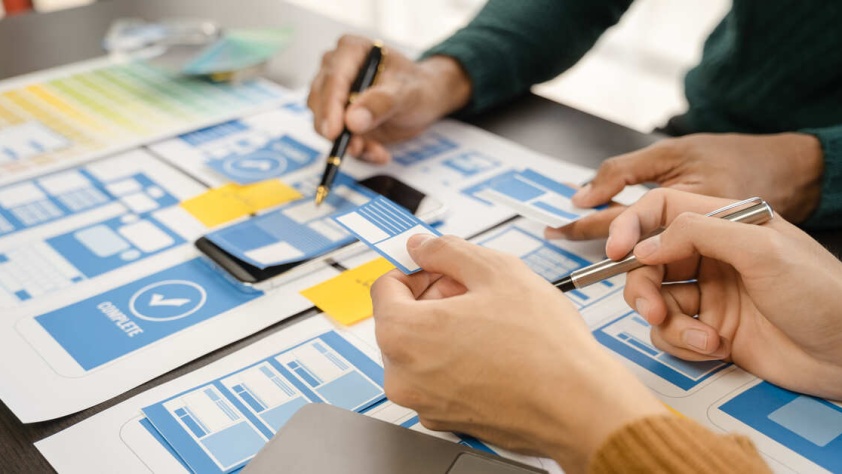Technological changes, shifting preferences of users, and new trends are some of the factors, which continue to experience a constant evolution of the web design landscape. To a designer, the only way to remain ahead of this dynamic environment is by ensuring continuous learning, flexibility and innovation. This blog examines some of the strategies that would enable designers to survive in the dynamic design world and stay competitive in the profession.
Getting Familiar with the Design Landscape
The design landscape comprises several elements such as graphic design, web design, user experience (UX), product design, and so on. Technology, culture and consumer behavior are some of the factors which affect it. With the emergence of new tools and methodologies, the designer should be ready to change their expertise and strategies to respond to the requirements of the market and the users.
The main Strategies of Remaining in the Lead
1. Embrace Lifelong Learning
Lifelong learning is essential in the hectic design industry. Designers are meant to take the initiative to widen their knowledge and skills. These may involve formal training, distance training, seminars and participation in industry conferences.
Coursera, Udemy, and Skillshare are only a few examples of platforms that provide numerous courses on various topics related to design, including the basics and the most advanced methods. Through lifelong learning, designers are always ready to keep up with the current trends, tools, and practices in designs.
2. Adhere to Industry Trends and Innovations
To be a relevant player in the design flash, it is important to be updated on the trends in the industry. To be informed about the latest innovations and techniques in design, designers are expected to read what is published in the design blogs, podcasts, and newsletters regularly. Social networks such as Behance, Dribbble and Awwwards also display the latest design work and inspire.
Social media, especially LinkedIn, Twitter and Instagram, may also be a good source of meeting the other designers and industry leaders. Being thought leaders and engaging in design conversations may give a clue to new trends and improved practices.
3. Practise with New Tools and Technologies
New tools and technologies are constantly creating the design landscape. Designers must be willing to test the new software, design platforms and prototyping tools. The process of getting acquainted with such tools as Figma, Adobe XD, or Sketch can make the work more productive and simplify the process of design.
Moreover, new creative opportunities and innovations could be provided through the use of the latest technologies, like augmented reality (AR), virtual reality (VR), and artificial intelligence (AI). By remaining on the cutting edge of technology, the designers are able to develop more interesting and interactive experiences for users.
4. Foster a Growth Mindset
The design landscape needs a growth outlook to be adopted to overcome the obstacles of the landscape. This attitude consists in perceiving failures as a chance to learn and improve instead of being a cause of setbacks. Feedback and peer critique should be welcomed and designers ought to be willing to do research on their work.
Designers can become more problem-solving and flexible by applying the growth mentality. This method allows experimentation and innovation, which allows designers to be bold and experiment with more creative opportunities.
5. Build a Diverse Skill Set
Flexibility is a desirable quality in the constantly shifting design environment. Designers ought to aim at creating a range of skills that are inclusive of different aspects of design. It may involve being proficient in various fields of design, including UX/UI design, graphic design, and branding, and getting familiar with front-end development and methods of user research.
A wide range of skills gives designers a wide range of perspectives to tackle projects as well as the ability to work in cross-functional teams. It is also highly employable because organizations usually target candidates possessing a broad pool of skills and knowledge.
6. Network and Collaborate
The networking is a great means of keeping in touch and aware within the design environment. Designers ought to also take the initiative to network with fellow designers, meet other designers at design fairs, and join design communities on the internet. Interaction with other people in the field can result in meaningful collaborations with others, mentors, and new ideas.
Growth also requires cooperation. Diverse personalities and experience may offer new insights and motivate new ideas. Joint projects usually are more solid and more innovative, and this is beneficial to all.
7. Focus on the User-Centered Design
User-centred design is an essential concept that must be applied to any design. It is important to know the user requirements, likes and dislikes as well as user behavior so that effective and meaningful designs can be achieved. Designers can spend time in user research, usability and gathering of feedback in order to make sure that their designs appeal to the target audience.
Through the consideration of user-centered design, designers are able to produce products that are not only capable of satisfying the user’s expectations, but also add to the overall experience of the user. This user orientation creates loyalty and satisfaction which has been the key to success in the competitive design environment.
8. Remain Flexible and Receptive to Change
Plasticity and flexibility are important qualities that designers should possess to survive in the constantly evolving design environment. Trends may change very quickly and new technologies may change existing practices. The designers should be ready to change and adapt to this change.
Designers are supposed to review their processes, tools and methodologies on a regular basis to remain flexible. This self-evaluation will enable one to improve constantly and to see the points about which change could be a positive factor. Designers can be relevant and innovative in their work by being open to new ideas and approaches.
Conclusion
To be ahead of the dynamic frontier of design, a proactive attitude must be employed, which will focus on lifelong education, flexibility and an integrated design approach that should be user focused. Designers can ensure that they survive in the world of design by focusing on lifelong learning, keeping up with industry trends, experimenting with new tools, and using a growth mindset to avoid the challenges of the design world.
Developing a variety of abilities, networking and user needs are key practices of a successful design career. Finally, following the information flow and keeping flexible, the designers will be able to survive in a changing environment and take part in new approaches to solutions that will define the future of design.
With the ever-changing nature of design, individuals who value the importance of learning, teamwork, and usability approaches will be not only able to remain in step with the change but will be the ones to develop effective and meaningful designs.
FAQs
- Why is design significant in technology?
Design in technology is important in making the experience more appealing, usable, and more attractive to the user. The good design has the capacity of distinguishing a product amidst a competitive market and creating customer loyalty.
- What design tools should I select in my project?
Some of the factors that should be considered include your need of particular design, the complexity of the project, level of skills of your team, and compatibility of the tools with other software. The most utilized ones are Adobe Creative Suite, Figma, Sketch, and InVision.
- What is user-centered design and why is it important?
User-centered design is one approach that takes into consideration the needs and preferences of end-users as regards to the design process. It is significant since it will produce more user-friendly and efficient products that satisfy the expectations of the users.




